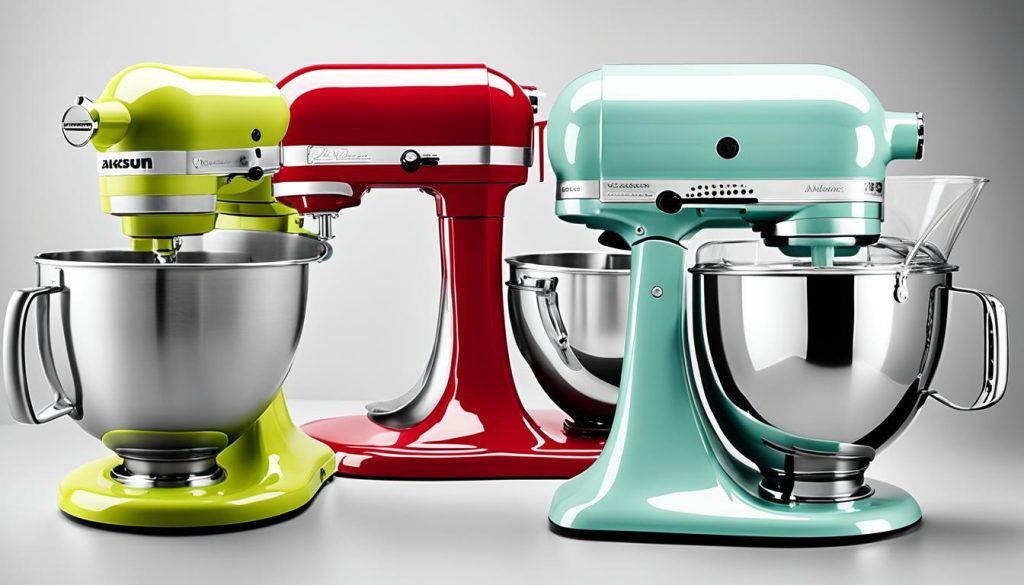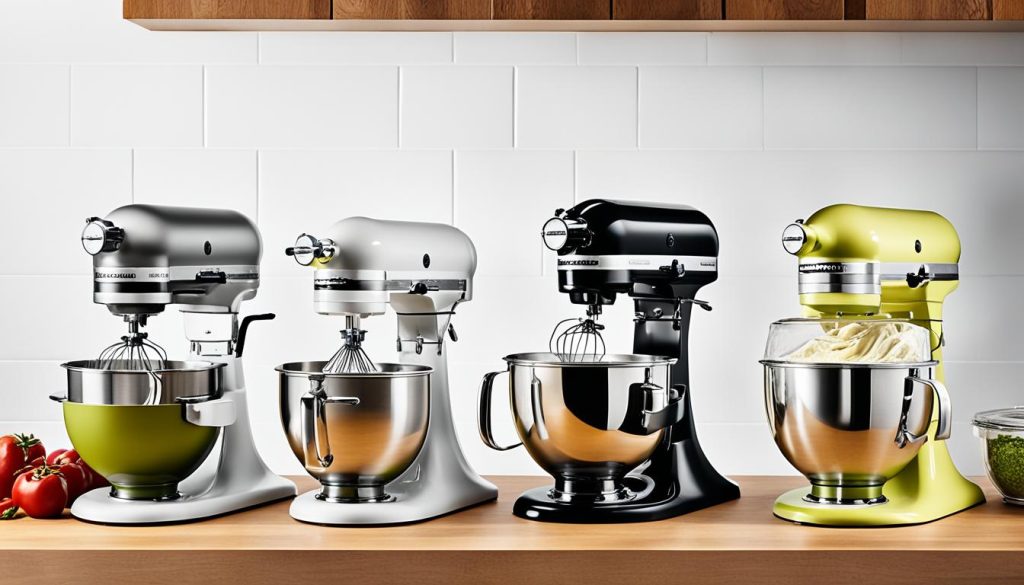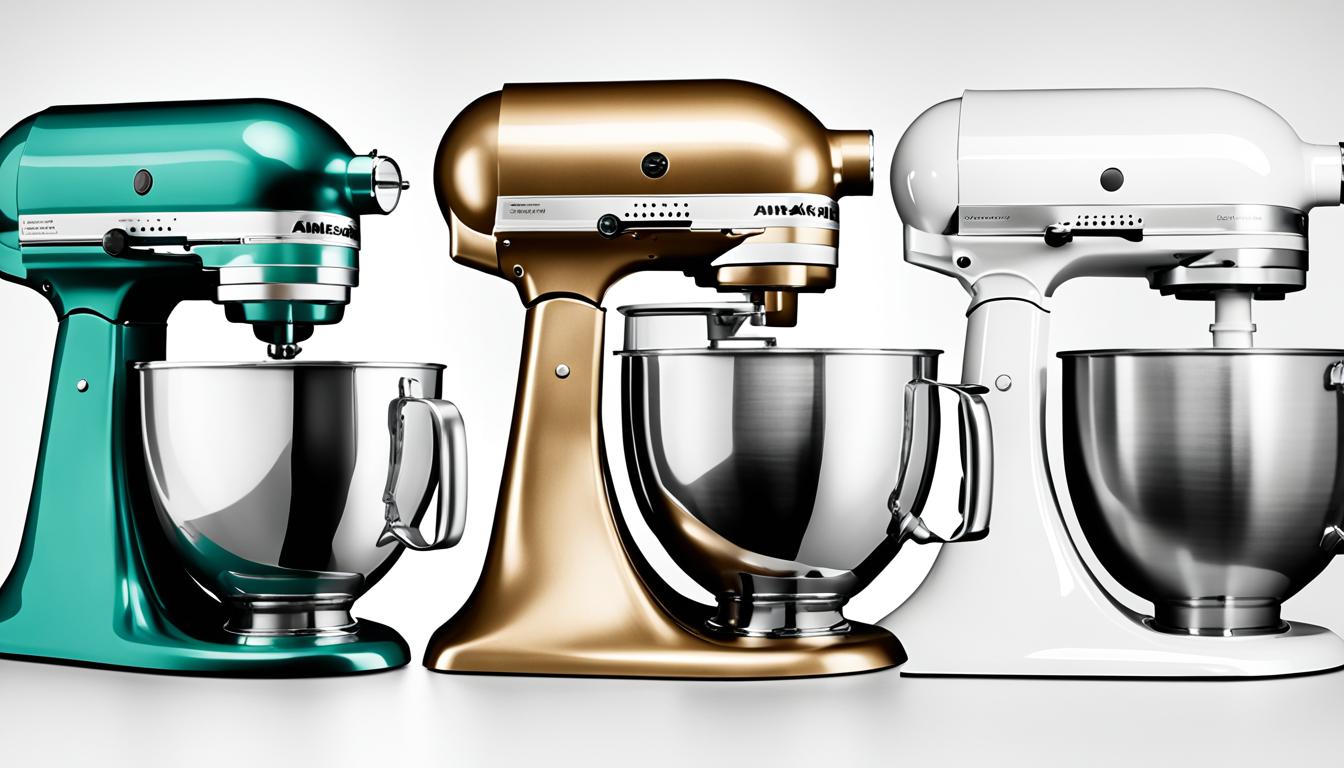Nearly 60% of home bakers say motor power is key when picking a stand mixer. This fact shows how important it is to know the differences between Ankarsrum and KitchenAid. They are top choices in the food-making world. Choose the right mixer, and your baking and cooking will reach new heights. This article will compare the two, helping you choose the best mixer for your needs.
Ankarsrum and KitchenAid both have long histories of being top-notch. They are loved by both home cooks and pros. But they differ in motor strength, what they come with, looks, and how easy they are to use. We will look at Ankarsrum’s sturdy Swedish roots and KitchenAid’s smart American style. This will help you pick wisely.
Key Takeaways
- Understand the key differences in motor power and efficiency between Ankarsrum and KitchenAid.
- Learn about the mixing bowl sizes and materials offered by each brand.
- Explore the range of attachments and accessories available for both stand mixers.
- Gain insights into the performance of each mixer in various cooking tasks.
- Evaluate user experience factors like ease of use, noise levels, and maintenance.
- Compare the price range and warranty offerings to determine long-term reliability.
Ankarsrum vs. KitchenAid: An Overview
When we talk about top stand mixer brands, two names always come up: Ankarsrum and KitchenAid. These brands are known for making high-quality mixers that chefs love.
History and Brand Reputation
Ankarsrum started back in 1940 and is all about Swedish design and lasting quality. It has always been a reliable choice for kitchen lovers. The KitchenAid, born in the U.S.A., has won hearts all over the world since it began. Its strength and the many things it can do have made it a favorite.

Design and Build Quality
Looking at design, both mixers have their own special features. The Ankarsrum has a bowl that moves, not the beaters. This is a cool way to mix things. The KitchenAid, on the other hand, moves the beaters in a circle and around the bowl. This way, it mixes things really well. Each mixer is different and brings something special to the kitchen.
Price Range and Warranty
Cost and warranty matter a lot to buyers. Ankarsrum mixers are usually more expensive but come with a great 7-year warranty. That’s good for anyone who wants their mixer to last a long time. KitchenAid mixers are often less pricey but only have a 1-year warranty. This might not be enough for some people who want more coverage.
To wrap up, both Ankarsrum and KitchenAid mixers are leaders in their field. They might appeal to different tastes because of their designs and prices, but they both offer amazing quality and power.
Key Features Comparison
When we compare stand mixers, we look at motor power, bowl size, and the extras. These make a big difference in how well your mixer works in the kitchen.
Motor Power and Efficiency
The motor’s strength in a stand mixer is key. Ankarsrum has a strong 600-Watt motor, made for tough doughs. KitchenAid has a 575-Watt motor, slightly less powerful. A stronger motor in Ankarsrum might mean smoother, more even mixes.
Mixing Bowl Size and Material
The size of the mixing bowl is also important. Ankarsrum shines with a 7.4-quart bowl and an extra 3.7-quart one. This is ideal for big batches. KitchenAid has a slightly smaller 6-quart bowl. The bowl material is crucial too. Ankarsrum uses stainless steel for durability and easy cleaning, while KitchenAid has stainless steel and glass choices.
Attachments and Accessories
Both stand mixers have lots of extras to boost their use. KitchenAid leads with its many colors and special attachments. This lets you personalize your mixer to match your kitchen and cooking style. Ankarsrum focuses on attachments that add to the mixer’s strength and long life.
In the end, the best choice depends on what you value most. Whether it’s powerful mixing, room for large recipes, or lots of extra tools, knowing about these stand mixer features can guide your decision.
Performance in Various Cooking Tasks
Choosing the best stand mixer means considering how well it does different cooking jobs.

Kneading Dough
The Ankarsrum stands out in kneading dough. It uses a special roller that mimics the way we hand knead. This makes the dough soft and stops it from being too hard. On the other hand, the KitchenAid’s spiral hook may sometimes make dough too dense.
Whipping Foams and Creams
For whipping up foams and creams, the KitchenAid is ahead. It has a unique way of mixing that’s great for small amounts, making them light and fluffy quickly. But when it comes to heavy mixing, like dough, the Ankarsrum might not work as well.
Mixing Batters and Doughs
When you need to mix batters and doughs well, both mixers do a good job, but they shine in different ways. The Ankarsrum can handle big batches with ease, thanks to its big bowl and strong motor. This ensures everything is mixed well. However, the KitchenAid is better for smaller jobs and delicate recipes. It focuses on precision mixing. Your choice depends on what kind of cooking tasks you do most in your kitchen.
User Experience and Usability
Choosing the right stand mixer changes how you cook. Think about how easy it is to use, the noise it makes, and how hard it is to clean. These factors matter a lot in keeping your kitchen running smoothly.
Ease of Use
Using a stand mixer means seeing if it’s simple to do what you want with it. The Ankarsrum mixer is different because it has a wide bowl and a special way it mixes. It’s good because you can add ingredients easily and have less to clean up. But, the controls might not be super clear the first time you use it.
KitchenAid, on the other hand, is well known for being easy to use. It has a head that you can lift up to add things without a mess. It’s smooth for some, but others might need to learn a few tricks to use it just right.
Noise Levels
Sound becomes important if your kitchen is always busy. The Ankarsrum mixer is quiet, so you can chat while it works. But, a KitchenAid can be louder, which might not be so great if you need a quiet space.
Cleaning and Maintenance
Keeping your mixer clean and in good shape is key. The Ankarsrum is made to be easy to wipe down and take apart for cleaning. But, it has parts that need a bit more care over time. KitchenAid, though, has a simpler shape. It doesn’t have too many parts to clean, but you might need to clean carefully because of how it opens.
FAQ
Q: What are the main differences between Ankarsrum and KitchenAid stand mixers?
Q: How do Ankarsrum and KitchenAid stand mixers compare in terms of price?
Q: Which stand mixer is better for making large batches?
Q: Can both stand mixers handle dense doughs?
Q: What kind of attachments and accessories do Ankarsrum and KitchenAid mixers come with?
Q: How do Ankarsrum and KitchenAid stand mixers perform in kneading dough?
Q: Are there differences in noise levels between the two mixers?
Q: Which stand mixer is easier to use and maintain?
Q: Do both mixers come with a timer feature?
Q: What is the better option for whipping foams and creams?
Q: Which mixer offers better customization options?
Source Links
- https://www.epicurious.com/shopping/this-swedish-mixer-is-more-powerful-than-a-kitchenaid-article
- https://www.everythingkitchens.com/blog/ankarsrum-assistant-mixer-vs-kitchenaid-professional-600-stand-mixer.html
- https://www.everythingkitchens.com/blog/stand-mixer-shopping-guide-kitchenaid-vs-bosch-ankarsrum-kenwood-smeg-cuisinart-mixer-comparison-review.html










